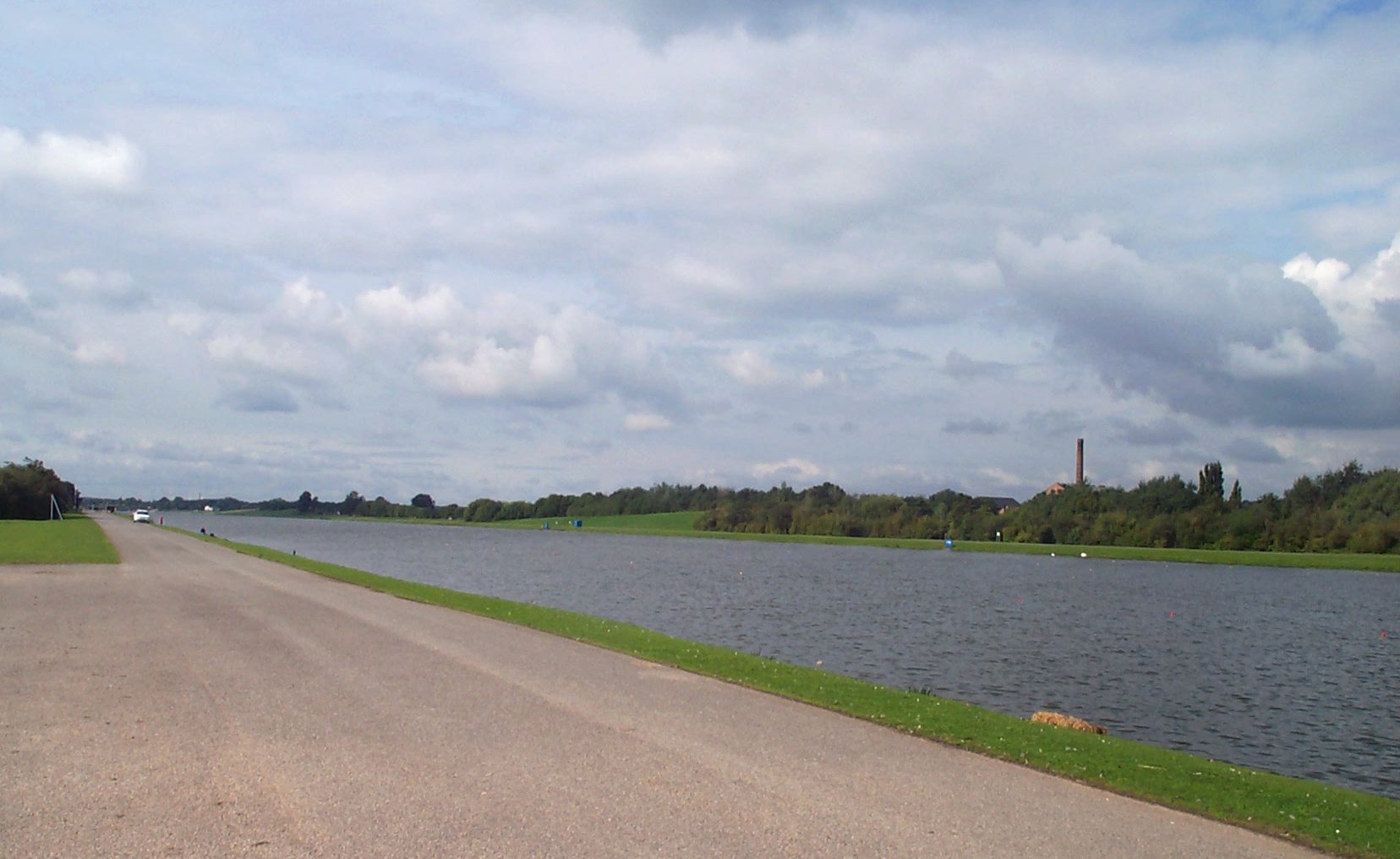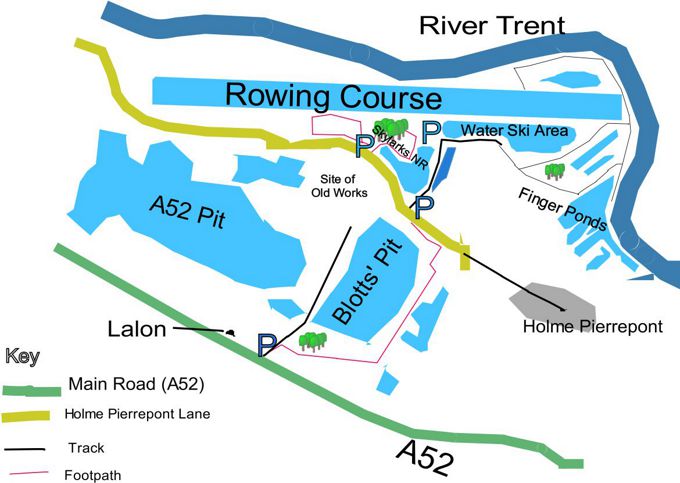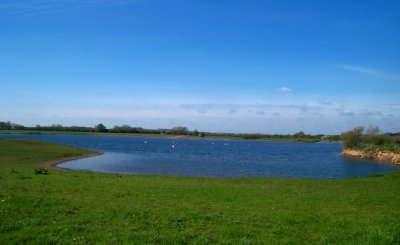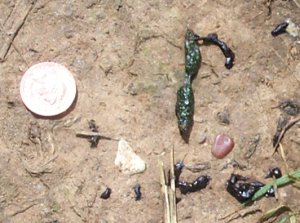
After many years, mineral extraction in this area is finished. The aggregate works have been removed and the land has been levelled. The Blotts' pit have been ‘landscaped’, with the banks having been graded and some areas have had trees planted. One of the pits is now used by fishermen. Some years ago Holme Pierrepont was considered as a site for a large coal-fired power station, which was finally built at Radcliffe on Soar, where the prevailing SW wind blows pollution over Nottingham.  Holme Pierrepont eventually became the National Watersports Centre, but even when built still had controversy – the rowers had complaints about its position – the prevailing winds allegedly came from the wrong direction, although it lies in a SW-NE direction; there were low catches at the 1994 world coarse fishing championships blamed on Cormorants, despite the fact that catches had been declining for some time prior to the arrival of Cormorants in the East Midlands. Its days as an international rowing centre are now finished, because it was built only seven lanes wide – present international events dictate eight. Even so many events are held at the watersport centre each year especially on summer weekends. The Robin Hood marathon, which is held on a September sunday passes through here. It is also a Country Park with activities such as angling, cycling and dog walking taking place.
Holme Pierrepont eventually became the National Watersports Centre, but even when built still had controversy – the rowers had complaints about its position – the prevailing winds allegedly came from the wrong direction, although it lies in a SW-NE direction; there were low catches at the 1994 world coarse fishing championships blamed on Cormorants, despite the fact that catches had been declining for some time prior to the arrival of Cormorants in the East Midlands. Its days as an international rowing centre are now finished, because it was built only seven lanes wide – present international events dictate eight. Even so many events are held at the watersport centre each year especially on summer weekends. The Robin Hood marathon, which is held on a September sunday passes through here. It is also a Country Park with activities such as angling, cycling and dog walking taking place.

The convenient places for parking in respect of birdwatching are marked with a "P" on the map. The Nottingham Transport bus service 11C goes to the watersports centre, but only on Sundays and Holiday Mondays. The Holme Pierrepont country park area is generally unrestricted access except on some event days, the Blott's Pits area has a public footpath running through the centre of it. The A52 pit is surrounded by private land, but there are viewing points, see the A52 section.
The A52 Pit is not easily worked as the land surrounding it is private. Views of it can be obtained
The Blotts' Pits can be worked from the A52 end, by parking in the small space at the entrance to a public footpath -- which at this point is actually a concrete track (this is the public footpath mentioned in the A52 pit access details) or from the north end by driving past the Watersports Centre along Adbolton Lane and parking at the north end of the public footpath, near to the Blotts' nightclub. The northern half of the larger of the pits will form part of the new enlarged Skylarks nature reserve, the southern half of the pit will be used by Hackett's fisheries. A scrape area for waders is being made, with viewing screens overlooking the area.
The finger ponds and scrub area is reached by taking the track to the right of the Ski centre. The main track finishes at the boundary fence with a large pasture field usually containing cows. There are various smaller tracks off the main one-- all are worth exploring. Part of this area is now ‘gated’ off as private, presumably to stop fly-tipping.
A 10 hectare site managed by the Nottinghamshire Wildlife Trust, originally opened in 1982 as an amenity for the nearby Winged Fellowship home, which is now closed. It is a disused gravel pit with the usual willow, birch and hawthorn, but also some open managed grassland. A lake which becomes a reedbed at the eastern end attracts riparian species such as Kingfisher. There is a circular pathway around the site. It can also be accessed from the Holme Pierrepont Country Park. Classed as a SINC (Site of Importance for Nature Conservation).
The Nottinghamshire Wildlife Trust is intending to buy the old aggregate works site on the south side of Adbolton Road. Also most of the larger of the Blotts' Pits will be included in the scheme. The area is at present being developed, with a new larger car park at the entrance.
The area mainly consists of worked out gravel pits. The 2Km long rowing course was cut over the top of old gravel and sand workings. Most of the rowing course and the associated buildings are surrounded by mown grass with the odd clump of willow trees. This is excellent for Geese–some years ago all the "farmyard" Geese and their bread scrounging companions were rounded up for the crime of defecating on the grass and shipped to add to the avifauna of Attenborough Nature Reserve. However there are still plenty of other habitat types at the east and south end of the site, including arable fields, pasture around the A52 pit, a small wood, a stream (the Polser Brook) and scrub areas around the area of the finger ponds.
Most of the site at the west end is either horse paddocks or a caravan park. The National Watersports Centre complex means joggers, dog walkers, cyclists, fishermen and even a few rowers. The watersports centre is the least attractive part from the birdwatchers point of view, the better areas lie further east.
The north-east end of the site (the so called finger ponds area), is different from the rest in that here the scrub has been allowed to grow around the ponds which were excavated differently from the rest of the site. This is definitely warbler friendly habitat, excellent for Chiffchaffs, Willow Warblers and Blackcaps. There is a track by the Ski club, to this area, which eventually ends at the site's boundary fence. This overlooks a large meadow which usually has grazing cattle and can get flood pools after wet weather, suitable for Snipe and other common waders. Another track also follows the river Trent finishing at the Regatta course.

The Blotts' pits area lie at the end of the Holme Pierrepont road and are called after the nearby nightclub of the same name. These two pits have been prime wader habitat in recent years whilst they were drained and being worked, but in August 2004 the pumps were switched off on the last pit. The westernmost pit is excellent for coots, ducks, geese and grebes and carries good populations of Gadwall, Wigeon, Teal and Shoveler. The geese are almost always Canadian and Grey lag – so don’t get too excited!!

Unfortunately there are resident mink in this area, as this photo, of their droppings, on the right, shows. The author also saw two animals a few years ago by the Blotts' Pits.
The A52 pit is the largest in this area and is very open with little cover on its banks. It is surrounded by pasture, but unfortunately the whole field is private and there is no access. For viewing points see the A52 section above.
Resident species include the expected Cormorants, many Mute Swans, Grey lag Geese, Canada Geese, Mallard, Little Grebe, Sparrowhawk, Nuthatch, Woodpeckers and Pied Wagtail.
Summer breeders are all the usual county warblers including Grasshopper Warbler and Lesser Whitethroat, Little Grebe and Grey Heron. On the Blotts’ Pits, Little Egrets and Hobbies occur regularly here in summer also.
Winter visitors include the expected Gull roost -- 1000+ birds at the turn of the year, and a wide selection of waterfowl, with notable numbers of Gadwall (often 50+), Mallard, Teal (100+), Wigeon (several hundred on the Blotts' Pit), Shoveler, Pochard, Tufted Duck (typically over 200), Pintail (a few in the winter), Goldeneye and Coot (1000+). Smew are seen most years on either the A52 pit, Blotts' Pits or finger ponds, and can also I suppose, travel over the river to Colwick country park.
Rare birds have included:Any criticisms, corrections or comments to the author Derek Huskisson

The text and photographs are licensed under a Creative Commons Attribution-Noncommercial-Share Alike 2.0 UK: England & Wales License.